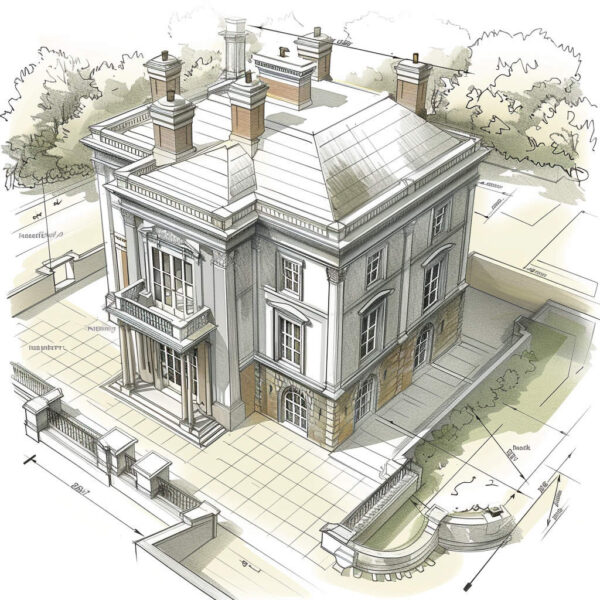
Planning Permission: A guide to what is it and when you need to apply
Building, modifying, or enlarging you home can be a daunting task, but it’s necessary if you want the home of your dreams. Planning permission is a necessary step in the process and there are different types that you may need depending on the project you are planning to build.
To get an understanding of the different types of planning permission and the application process, you can find information on your local council’s website, but it can also be beneficial to consult an architect. If you hire an architect, they will help guide and support you through the process and if they act as your planning agent, they will manage the application on your behalf. Once planning permission is granted, there may be some further steps you need to take before you can start construction, such as discharging planning conditions and applying to Building Control.
How to know if you need planning permission?
Before starting any building project, it is important to know if planning permission is required. Some extensions and alterations may fall under permitted development rights, meaning formal planning permission is not required.
However, if you’re not sure, it would be best to get in touch with your Local Planning Authority or a local architect as applications can sometimes be complex, and you don’t want to risk making mistakes. If consulted in time and with due care, an architect could help save you time and money during the application process by providing insights about specific aspects of your proposed build that may not have been considered yet. In short: always consult an expert before making any decisions!
How Long Does It Take to Get Planning Permission?
Applying for planning permission can sometimes be a complicated process, but it is important to know the ropes. Depending on the type of application made, it can take anywhere from a few weeks to several months to get approval. However, this timeline will vary depending on the complexity of the request.
A householder or full application are usually decided within 8 weeks. However, if the correct documents are not submitted then this can delay the process and often some local councils are unable to keep up with the demand and cannot meet this deadline.
Speaking with an expert can be beneficial for a timely planning decision as can help you make informed decisions about your project to make an approval more likely. They will also know about all the correct documentation and drawings that need to be submitted and if they act as your planning agent, will chase the local council on your behalf.
Where to find information about planning permission
When it comes to planning permission it’s important to have all the information at your disposal before starting anything. Luckily, there are many resources available online through the UK government website or through contacting your local council. The planning portal has easy to use interactive guides that explain the types of permission and what the rules are.
Getting advice from an architectural professional should also be considered – they will know the ropes and could save you time and hassle during the application process. In the case of an architect, they will generally design your project for you, produce the drawings, submit the application, and manage your application with the council, making it a simple process for you.
What are the different types of planning permission?
There are two types of planning permission that you are likely to need for your residential project – Householder and Full. For modifications or additions to a single home (but not a flat), householder planning applications are more appropriate. When submitting plans for projects that are not covered by a householder application or permitted development rights, a full planning application is necessary – generally for any new buildings, any commercial projects, or a change of use.
Permitted development rights allow certain types of development by national legislation, without the need to submit a planning application. If your project falls under these rights, it can still be beneficial to apply for a lawful development certificate, which is a legal document stating the project is lawful. It’s important to note that planning permission is always a good idea – it provides legal certainty and clarity.
How to get planning permission for a new home?
To get planning permission for a new home, you will need to submit a full planning application to your local council. The application process can take 8 weeks for a “minor” project and there is a fee involved.
For more complex projects, a pre-application can be submitted in order to get the councils view on the principle of the project before actually submitting a full application. This prevent a refusal and can inform you on what the council thinks is appropriate and achievable on the property.

When Will I Need Planning Permission for an Extension?
When planning to extend your property, you first need to check if any planning permission is required. Some extensions may fall under permitted development rights, and so formal planning permission is not required.
Larger or more complex extensions can be applied for under householder applications, which require a bit more information and for you to wait for approval before any works can begin. Rear or side single-storey extensions that are a certain depth from the back of the property and loft conversions usually fall under permitted development.
Larger rear extensions may fall under the prior approval scheme, this still comes under permitted development, but seeks consent from neighbouring properties. Two-storey extensions, extensions to the front of the property and other types of extension will usually require a householder application.
Planning permission for garages, sheds and other outbuildings
Depending on the location and size of the outbuilding, you might need planning permission first – some sheds and outbuildings may be allowed under permitted development rights. This would usually include structures that are small in comparison to a house or other building.
However, if the shed or outbuilding is more substantial than a simple garage or shed, it might require formal planning permission from your local authority. Buildings and other structures that exceed specified dimensions can also require approval from the council if they are considered an extension of the home rather than just another Shed/Garage!
How Long Does Planning Permission Last?
Planning permission lasts for 3 years from the date it is granted. After this date, the permission will have expired, meaning you will need to reapply in order to get the consent. By implementing your project before the expiry date, you’ll avoid having to go through the hassle of another application. This is why it is important to have a plan for your project.
What Happens if you Build Without Planning Permission?
Anyone planning to build without the required permission could end up in some serious trouble. From serious fines to demolition, getting it wrong can have a major impact on your project, finances and home.
In some cases, a retrospective application or lawful development certificate application can be made to provide a legal document confirming the project is legitimate. There is no doubt that consulting with an experienced architect will help you get all the necessary permission for your project – and can help to avoid costly mistakes down the track!
Should I Use an Architect to get Planning Permission?
When it comes to planning permission, hiring a consultant is usually the faster and easier option. If you’re planning any projects to your home, or you’re not sure if the proposed works are permitted, it’s a good idea to get in touch with a local architect. An architect will be experienced in what is likely to be approved and rejected, they will have access to all the relevant information and can provide you with an expert opinion on what needs to be done in order for your project to go ahead smoothly.
The main advantage of using a consultant is that you get everything taken care of without any hassles or delay. An architect can also work with you to design and optimise your spaces and make them bespoke to your needs. They can also produce all the necessary drawings and documents required for the submission and deal with the application and the correspondence with the council. A consultant will usually charge you a fee for their services, so this is something to consider. In the end however, it’s important to take both pros and cons into account before making a decision – ultimately finding someone who ticks all the right boxes may just turn out being the best decision after all!
What Planning Application Drawings do I Need to Supply?
When planning to carry out a project, it is important to have the right planning application drawings. This will help ensure that all necessary information is supplied for the council to accept the application. The local council will usually have a list of required documents or drawings that need to be submitted for the application. Submitting the wrong information or not enough information can cause delays or even refusal of consent, so make sure you take every precaution possible.
Frequently Asked Questions
Should I use an architect, a surveyor or both when applying for planning permission?
When it comes to planning your dream home, it is always a good idea to consult with a professional prior to submitting your application in order to get the best advice possible. And make sure that all materials provided in your submission (e.g. drawings, specifications) are properly labelled and dated so as not to confuse or delay the process of approving/rejecting your application. An architect should be your first port of call and they can usually advise on whether a surveyor will be required.
How long will it take for me to receive the final decision on my application?
The application process can typically take eight weeks to complete. Once your application is received, the planning department of the council will go through it and decide if it meets the eligibility requirements. If everything is in order, they will then send you an email confirming that they have granted permission and specifying next steps. With the help of your architect or consultant, you can then coordinate the necessary procedures so that construction can begin as soon as possible.
Conclusion
Planning permission is an important process that must be followed if you want to build a new home or extend/modify an existing one. By understanding the different types of planning permission and when you will need them, you can make the process easier. In addition, the advice provides helpful tips on obtaining planning permission for a new home or extension, how long planning permission lasts and what happens if you build without permission. For any further information on planning permission, or to undertake a project of your own, be sure to check out our website or contact us via phone or email.



